How Much Does Hydro-Jetting Cost?
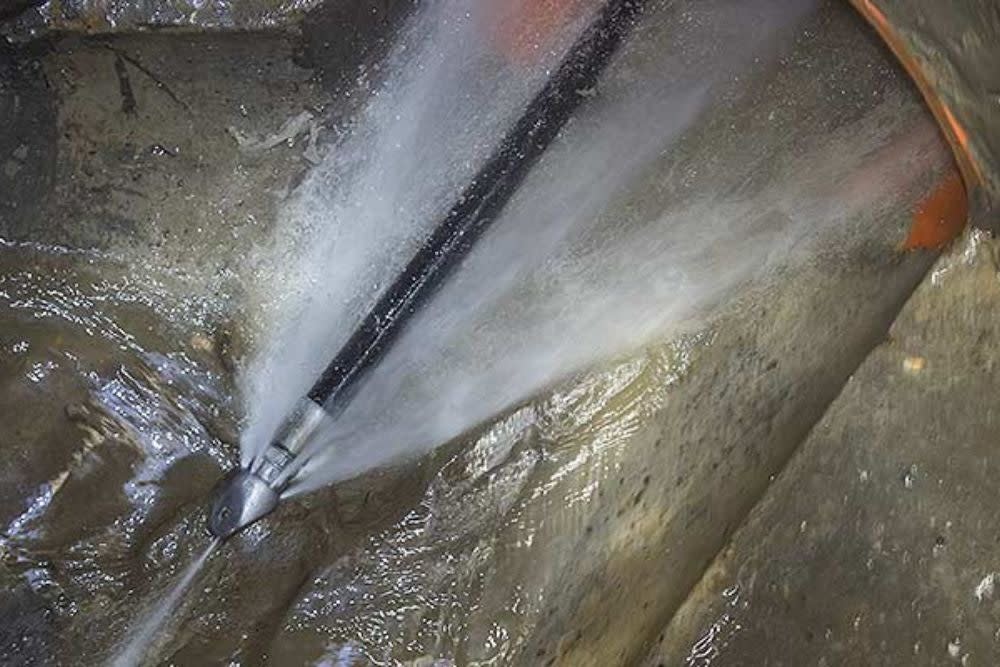
Highlights
Hydro-jetting costs $475 on average, though homeowners can expect to spend between $350 and $600.
The cost to hydro-jet sewer lines depends in part on the severity of the clog, how accessible the sewer line is, labor rates, and whether additional repairs and replacements are needed.
Common signs that a sewer line might require hydro-jetting include frequent backups, clogs, unpleasant odors, gurgling pipes, and slow-running drains.
Most cities require that sewer line inspections, cleanouts, and repairs be completed by a licensed plumber who has the experience and equipment to properly do the job without risking further damage to the city’s main sewer lines. Consider vetted professionals from top companies such as Mr. Rooter and Roto-Rooter.
Hydro-jetting is a powerful plumbing method that uses high-pressure water to clear pipes of debris. The technique also helps prevent future clogs and prolongs the life of a home’s plumbing system. Hydro-jetting sewer lines uses more force than typical pressure-washing. Plumbers can force water through the pipes at a rate of 4,000 to 35,000 pounds per square inch (PSI).
“A hydro jetter or jetter is essentially a giant power washer specifically designed to clean and flush the interior surfaces of drain pipes,” explains Hendrik Van de Poll, master plumber and co-owner of Service Force Plumbing in Rockville, Maryland.
A typical cost range for hydro-jetting services is $350 to $600, with the average hydro-jetting cost coming in at $475, according to Angi. Several factors influence the final cost, including the severity of the clog, the plumbing system’s accessibility, and local labor rates. Though it can be a somewhat costly undertaking, a hydro-jetting service lets homeowners enjoy free-flowing drains and a safer environment without contamination risk.
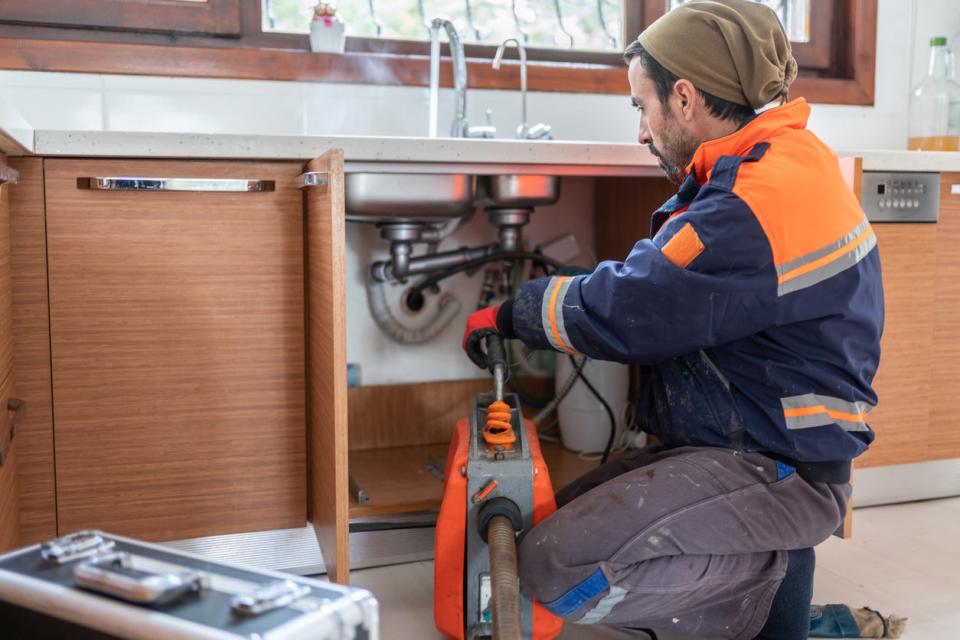
Photo: istock.com
Factors in Calculating Hydro-Jetting Cost
The average hydro-jetting cost depends on a wide variety of factors, not the least of which is how severely the pipes are clogged. In addition, systems that have adequate accessibility may cost less to service than those that are difficult to access. Finally, local labor rates will affect the final cost since urban areas tend to have higher rates than suburban cities or more rural areas.
Clog Severity
The severity of a clog is one of the most significant factors when it comes to estimating the cost of hydro-jet drain cleaning. The more severe the clog, the longer it takes to clear the pipes. Since plumbers typically charge by the hour, the extra time spent on a difficult obstruction has a considerable impact on the final price.
It’s not just about the time involved, though. Dealing with severe clogs may also require specialized equipment and additional expertise, both of which can come with a higher base fee. Severe clogs can also be discovered in an emergency situation, which often brings its own set of higher costs. Finally, persistent severe clogs can require multiple visits from a plumber for ongoing assessment and maintenance, with each visit contributing more to the final price.
Sewer Line Accessibility
The closest access to sewer lines is commonly found in a home’s crawl space, basement, or garage. The accessibility of a sewer line significantly impacts the price of hydro-jetting since drain and sewer cleaning can take longer when the lines are more challenging to reach or there are obstructions to work around. Since sewer lines are connected to the city’s pipes that run under the streets, plumbers may also need to access the sewer line in the yard, and that usually means digging into the landscaping.
Sewer lines that are sealed off or covered require extra time and effort to access, contributing to higher overall costs. In addition to the extra time needed for the job, a plumber may charge more for the job’s complexity. If this is the case, homeowners can ask about sewer cleanout installation costs to add entry points to the sewer system. This can reduce the cost for future appointments since a plumber will be able to more easily access the lines.
Labor
The average plumber’s salary and hourly fees can vary by geographic location. An hourly plumber rate can be as little as $45 or as much as $200, making labor costs one of the most substantial factors to account for when budgeting for hydro-jetting services.
Labor costs vary since highly skilled or specialized plumbers often charge higher hourly rates, while newer plumbers tend to have lower starting rates since they are learning how to grow a plumbing business. Also, complex or more challenging hydro-jetting jobs may require additional team members to complete the job efficiently and safely. When this is the case, homeowners would pay for each additional plumber’s hours.
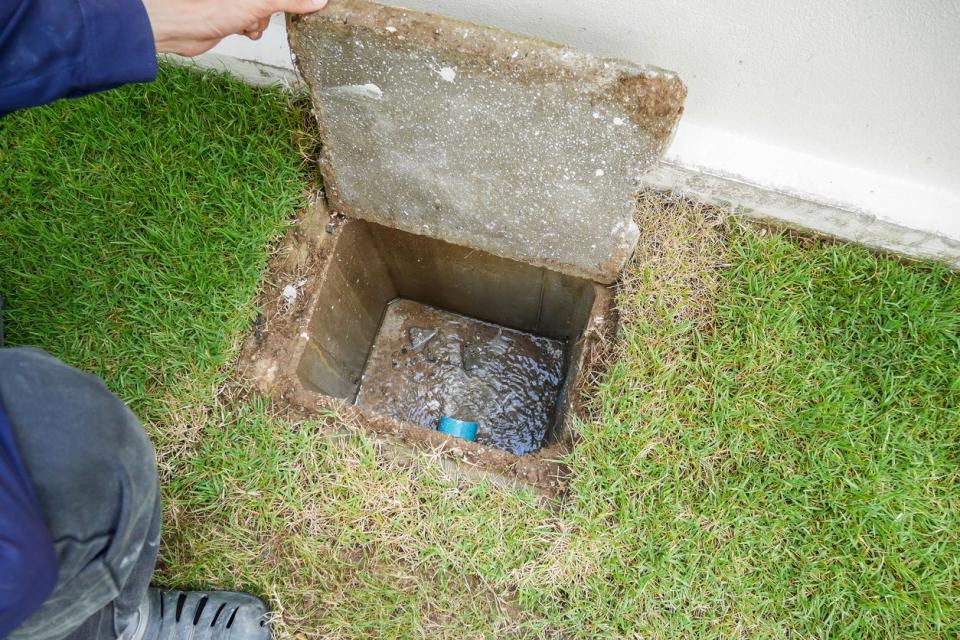
Photo: istock.com
Additional Costs and Considerations
In addition to the basic service charges, homeowners may experience other potential costs associated with water-jetting sewer pipes. For instance, some homeowners may have to repair or replace sewer lines and toilets, while others may need to remove tree roots. An inspection is a wise choice for nearly every situation, though.
Sewer Line Inspection
During a sewer line inspection, a special camera is inserted into the pipe to assess the condition and integrity of the lines. Sewer line inspections are often a vital portion of a hydro-jetting service. They can help identify potential problems, such as existing damage in the sewer line that may worsen during the hydro-jetting process. Plumbers can then make adjustments to their process or recommend additional repairs.
In some cities, a sewer line inspection is required before a plumber can complete any work. Homeowners who fail to have an inspection done may be fined if damage occurs to the main sewer line, even if it’s determined that they were merely negligent in addressing a problem soon enough. Municipalities take sewer line clogs seriously since they can quickly affect other homes on the same sewer line, so some municipalities have strict regulations about sewer work. Whether required or not, a sewer line inspection typically costs anywhere from $275 to $1,175. Homeowners with larger homes or properties with complex layouts can expect to pay more.
Sewer Line Repair or Replacement
Sewer line repair or replacement involves fixing or replacing damaged or deteriorated sections of a sewer line. It’s possible either or both steps may be necessary depending on the severity of damage. For example, pipes can crack, fracture, or break due to tree roots or corrosion over time.
Older sewer lines often show signs of deterioration that can’t be repaired. And persistent blockages may be best addressed by replacing a section of sewer line (especially if hydro-jetting isn’t clearing the blockage).
Whatever the cause of the damage, it’s wise for homeowners to invest in repair or replacement. Homeowners can expect to pay between $60 and $250 per linear foot, with the typical repair job costing about $2,900.
Toilet Removal and Replacement
Removing and replacing a toilet may be necessary if there are severe clogs or pipe damage. Toilet removal costs typically range from $50 to $200, while installing a new toilet costs an average of $370. While toilet removal and replacement can be a DIY job for experienced homeowners, hiring a professional plumber reduces the chance of installation issues that can cause leaks in the future.
It’s important for homeowners to understand that toilet removal costs and toilet replacement costs are not the same. It may be helpful for homeowners to set aside additional funds in case the need to remove and replace a toilet arises.
Tree Root Removal
Nearby tree roots in a yard can penetrate sewer lines as they grow. Once this happens, sewer line blockages are a common problem. If not addressed, tree roots can seriously damage sewer line pipes and eventually cause them to fail. The good news is that high-pressure hydro-jetting can effectively remove tree roots, though it’s more costly than a hydro-jetting job that doesn’t have to remove tree roots.
Tree root removal from a sewer line typically costs an extra $100 to $600 beyond basic hydro- jetting costs. It may be helpful for homeowners to know that some insurance policies cover tree root removal. Homeowners who are facing tree removal costs may want to check with their insurance provider to see if their policy covers any of the expense.
Two-Way Sewer Cleanout Installation
A two-way sewer cleanout provides easier access to a sewer line via a specialized access point. Adding a cleanout allows plumbers to conduct inspections, maintenance, and hydro-jetting appointments faster and more easily. It might also make it easier and cheaper to address sewer line problems before they become more severe.
Two-way sewer cleanout installation costs about $2,000 in addition to any hydro-jetting or other services that may be required. Homeowners often consider installing a two-way sewer cleanout after booking a hydro-jetting service that uncovers a massive clog. Homeowners often find the additional cost is worth considering when budgeting for hydro-jet sewer cleaning.
Sewer Backup Cleanup
The average clogged sewer line cost can quickly increase when a professional cleanup is required. Sewer backup cleanup usually involves cleaning and disinfecting any contaminated areas to make the space safe and habitable.
The Institute of Inspection Cleaning and Restoration Certification (IICRC) categorizes raw sewage as Category 3 contaminated water or blackwater. This level indicates that the water likely contains viruses, bacteria, parasites, and other harmful microbes that pose a significant health risk to anyone exposed.
Deciding to forgo sewer backup cleanup can lead to health hazards and further property damage. While sewer backup cleanup costs can range from $1,000 to $5,000, a thorough cleaning is always the recommended approach to avoid compromising the health of the home’s occupants and prevent mold growth. Homeowners who experience raw sewage backup or flooding from storm or river surges will want to call one of the best water damage restoration services (such as ServiceMaster Restore or ServPro) and find out how much water damage restoration costs to ensure their home is properly cleaned after contamination.
Residential vs. Commercial
Significant price differences exist between residential and commercial properties that need high-pressure drain cleaning. While it can cost $1,000 to clean a residential sewer line, a commercial sewer line may cost up to $3,000. The increased price is often due to pipe size and length since commercial properties have larger and longer pipes than residential homes.
Commercial properties have more complex piping and sewer systems than residential homes, and they have higher occupancy rates. Clogs may be more frequent and more severe. Additionally, commercial properties may need to adhere to specific regulatory standards that affect the frequency and type of hydro-jetting maintenance performed on a building.
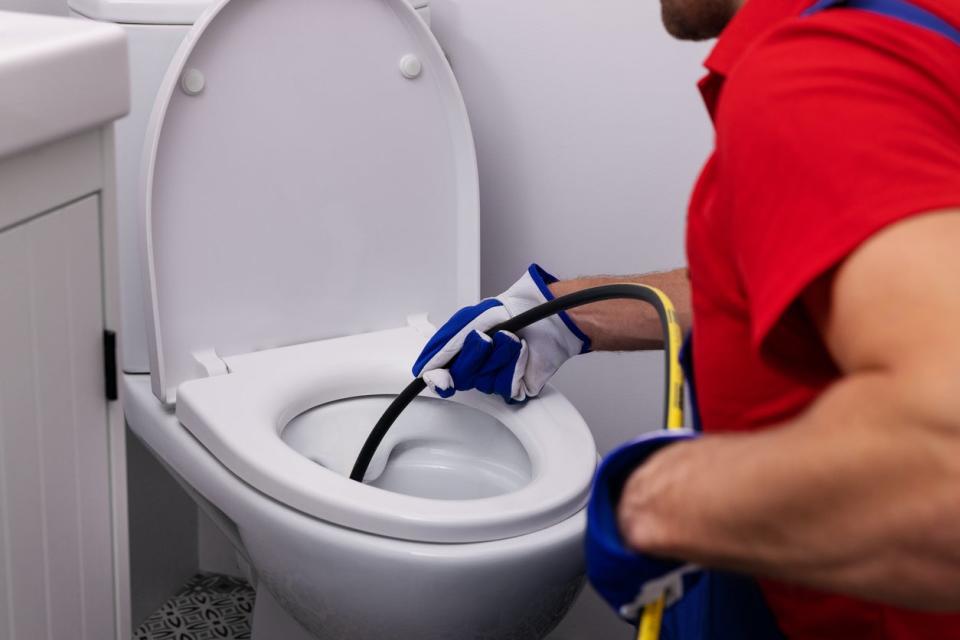
Photo: istock.com
Do I need hydro-jetting?
Hydro-jetting may not be a frequent part of a home’s overall maintenance routine, but there are other times when it becomes a sudden necessity. When a homeowner deals with frequent sewage backups, unpleasant smells, or slow drains, it may be time to schedule a hydro-jet plumbing appointment.
“There are two key situations [in which] we use a jetter,” says Tyler Pittenger, a plumbing technician who is also with Service Force Plumbing. “The first is as a follow-up tool after clearing a clogged drain or sewer. The second is as a preventive maintenance tool in situations where this kind of buildup is a known factor and needs to be addressed regularly.”
Frequent Backups
While occasional plumbing backups may happen inside a home due to minor clogs, frequent backups are not normal. If sinks or drains are backing up regularly, there may be a buildup of debris or grease, or there may be other obstructions.
Hydro-jetting is an effective method for clearing and preventing blockages that DIY methods, such as plunging, cannot repair. It’s also important to note that DIY chemical drain cleaners can worsen the problem. Ignoring frequent backups can lead to worsening clogs and potential pipe damage. For these scenarios, homeowners are advised to schedule an appointment with a plumber.
Unpleasant Smells
Unpleasant smells coming from plumbing fixtures may resemble a foul, sewage-like odor or a musty or rotting smell. An accumulation of grease, food debris, or other organic matter in a home’s pipes are all potential causes of unpleasant odors. Other causes are raw sewage or stagnant, bacteria-laden water that are clogged in the lines.
There are DIY measures a homeowner can take to eliminate minor unpleasant odors, such as baking soda and vinegar or commercial drain cleaners. Homeowners can also look into how to clean a jetted tub or how to clean a dishwasher to slow down the return of unpleasant smells, though relief may only be temporary if the odor is caused by a blocked sewer line. Professional sewer or toilet- jetting services will likely provide a more effective and lasting solution.
Noisy or Gurgling Pipes
Noisy or gurgling pipes suggest air or water is struggling to pass through blockages or narrowed passages within the pipes. The noise from blocked pipes can sound like bubbling when a sink, shower, or other plumbing fixture is used.
DIY tactics (such as using a plunger) may offer temporary relief for a minor blockage, but unless the root cause of the sound is addressed, it’s likely to return. Hydro-jetting can clear the obstructions within a pipe and restore normal flow. Noisy or gurgling pipes are a sign that the plumbing system is stressed, so they’re helpful symptoms that alert a home’s occupants to call a plumber sooner rather than later.
Recurring Clogs
Plumbing systems are undoubtedly convenient, but clogs are not. Clogs offer several warning signs to a home’s occupants, including:
Slow drainage in sinks, tubs, showers, or other plumbing fixtures;
Water backing up in one fixture when another is in use; and
Gurgling noises from drains.
DIY methods, such as plunging or using chemical drain cleaners, may temporarily resolve a minor clog. The cost to snake a drain may be worth considering since this is an affordable method to try on a first-time clog. But for recurring clogs, hydro-jetting is the most proactive solution for addressing the clog’s root cause and preventing future blockages.
Slow-Running Drains
A slow-running drain is likely to be blamed when a shower suddenly turns into a bath. Depending on the drain in question, common causes of slow-running drains include soap scum, grease, or hair in the pipes. DIY methods, such as using a drain snake, may help speed up draining. If the problem returns quickly, then hydro-jetting is the best approach for eliminating slow-running drains and preventing future blockages.
It’s important to note that slow-running drains can lead to more severe blockages and even potential pipe damage if left unaddressed. While the issue may seem like more of an inconvenience than a major concern, it’s best to have a plumber evaluate slow-running drains to see if hydro-jetting is the best method for restoring optimal drainage.
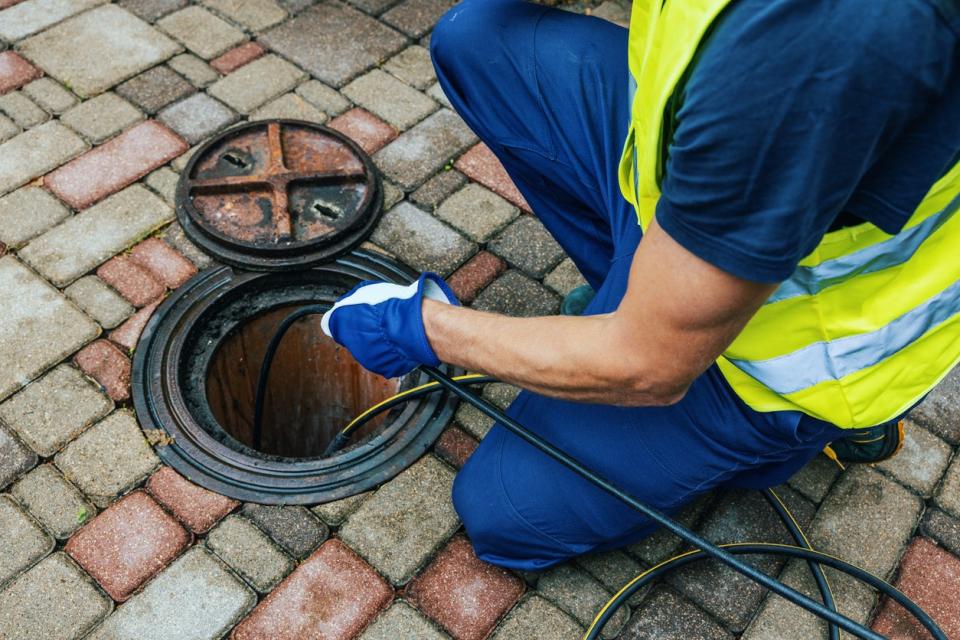
Photo: istock.com
Hydro-Jetting: DIY vs. Hiring a Professional
While it makes sense that a homeowner would want to save as much money as possible on hydro-jetting, taking a DIY approach to save on labor costs is rarely an option. Hiring a professional is always the recommended route for many reasons—not the least of which is safety.
Lack of equipment: The average homeowner likely doesn’t have the right equipment to properly hydro-jet a sewer line with enough force.
Safety concerns: Hydro-jetting uses water at incredibly high pressure rates. The potential for injury can be significant with an inexperienced operator. There’s also a risk of personal contamination from raw sewage during the inspection and cleaning process.
Legal restrictions: In many areas, DIY hydro-jetting or any other type of sewer line repair is not legal and can only be conducted by a licensed plumber.
Costly mistakes: Older plumbing systems are prone to damage from hydro-jetting. Experienced plumbing professionals know how to mitigate the risk without increasing the risk for additional repairs due to human error.
Financial considerations: A portable hydro-jetting machine costs between $1,500 and $2,000, which is a costly investment for infrequent use.
“There are so many things that could go wrong, even with one of the small jetters,” warns Pittenger. “You could get the hose end stuck. You could get it turned back on itself into a tangled pretzel. You could send the hose into an unknown branch line and not even be cleaning the drain you intend to. You could make a giant mess if the water and gunk back up the pipe. And unless you also have a fiber-optic camera, you won’t be able to investigate and ensure that you cleared the line properly.”
Professionals have the knowledge and equipment to ensure a thorough and efficient hydro- jetting service. They may also be able to help with other plumbing repairs or answer questions about other areas of the home, such as how to get rid of washing machine smells or what the best whirlpool tubs for a bathroom remodel are. Whether a homeowner is searching for an experienced hydro-jetting plumber or the best drain cleaning services by Mr. Rooter or Roto-Rooter, finding the best professional starts with diligent research.
How to Save Money on Hydro-Jetting Cost
Plumbing clogs and obstructions can surprise homeowners—so can the cost to fix them. While hydro-jetting is effective, it can be an expensive maintenance fee for some homeowners to absorb. Keeping the following tips in mind can help homeowners save money on costs, ensuring a home’s pipes are correctly fixed without going over budget.
Address issues promptly: Any signs of a plumbing system in distress ought to be addressed quickly. Early detection can help prevent the need for emergency services and additional repairs.
Be flexible with scheduling: If the symptoms of a clogged sewer line aren’t severe, homeowners may be able to save on emergency service fees by being flexible with the repair scheduling. Some plumbers may offer discounts during less busy times of the year when fewer homes are being built.
Obtain multiple quotes: It’s wise for homeowners to reach out to at least three different contractors for quotes. Comparing pricing, experience, and included services helps homeowners find the option that offers the most value.
Combine services: Bundling hydro-jetting with other necessary plumbing services or repairs may result in a discounted rate or lower negotiated cost.
Keep up on regular maintenance: One of the best ways to avoid hydro-jetting costs is to prevent the need for it as long as possible. Keeping up on regular maintenance, scheduling professional inspections, and being mindful of what goes down the drains can help avoid unnecessary or premature hydro-jetting procedures.
Questions to Ask About Hydro-Jetting
For most homeowners, there’s no shortage of options when it comes to finding a plumber. The challenge is combing through a long list of professionals to find the best plumbing services in their area. Asking the following questions can help homeowners vet their options quickly and effectively.
Are you licensed and insured for plumbing services in this area?
Are you experienced in hydro-jetting?
Do you have a list of references or any online reviews to share with me?
What is included in your service quote?
How will you ensure hydro-jetting won’t damage my older pipes?
What specific hydro-jetting equipment and techniques do you use?
When can you add my hydro-jetting service to your schedule?
Do you offer emergency hydro-jetting services?
Will you need to access the sewer from inside the house or the yard?
Do you provide preventive maintenance plans to help me avoid future plumbing problems?
What if hydro-jetting doesn’t solve my plumbing problems? What’s the next best step?
What safety measures do you take to prevent damage to my property?
FAQs
Hydro-jetting is an efficient plumbing technique for removing stubborn clogs and preventing future blockages. It’s also ideal for cleaning a home’s sewage system after years of use. Overall, hydro-jetting costs are a wise investment for homeowners who see early signs of sewage blockage and want to avoid major repair issues in the near future.
Q. How much water does hydro-jetting use?
The amount of water used during hydro-jetting is determined by the pressure and flow rate needed to clear a blockage, which can vary between homes and service appointments. Typically, hydro-jetting involves pressurizing water to at least 4,000 PSI, which can deliver as much as 20 gallons of water per minute. A single hydro-jetting session can take a few minutes or several hours depending on the severity of the clog and the number of sewer lines.
Q. Can hydro-jetting damage pipes?
While hydro-jetting is considered relatively safe for a home’s plumbing system, there is some risk. The intense pressure exerted during the process can potentially damage old or weakened pipes. PVC pipes are generally considered safe for hydro-jetting, while fragile materials such as clay or certain types of cast iron may be more prone to damage.
Q. How often should you hydro-jet a sewer line?
When hydro-jetting is used as a preventive measure, professionals recommend treating a sewer line once every 1 or 2 years. However, older plumbing systems may require more frequent maintenance. Systems that are more prone to clogs may benefit from more frequent hydro-jetting sessions to maintain optimal flow. Consulting with a professional plumber is the best way for a homeowner to establish an appropriate hydro-jetting schedule for their system.
Q. How long does it take to hydro-jet a sewer line?
Hydro-jetting a sewer line typically takes between 1 and 2 hours for an average-size home. However, the duration of a hydro-jetting appointment can vary based on several factors. To estimate the time, a plumber considers the length of the sewer line, the severity of the blockage, and whether there are any challenging situations, such as root intrusions or a complex pipe layout.
Q. What are the disadvantages of hydro-jetting?
Hydro-jetting is an advanced plumbing technique that offers several advantages, but there are some potential drawbacks. First, hydro-jetting tends to be more expensive than other options since it must be performed by trained professionals. Second, hydro-jetting could cause damage to certain kinds of pipes if they’re not properly inspected first. Before an appointment, a camera inspection is often required to check the system’s structural integrity. This step minimizes risk but comes at an additional cost.
“Hydro-jetting is a different animal altogether than other drain cleaning methods, and there isn’t a whole lot of crossover,” explains Van de Poll. “There’s really no other tool that can clean the entire length of a drain or sewer as effectively and quickly as a jetter. Hydro-jetting services can be somewhat expensive, because the machine costs tens of thousands of dollars, and hundreds of gallons of water isn’t necessarily cheap, either.”
Q. Does hydro-jetting remove roots?
Yes, hydro-jetting removes tree roots by using extremely high-pressure water to cut and clear them from sewer lines. Before beginning, a plumber will perform a camera inspection to pinpoint the location of any roots, ensuring targeted treatment. While many homeowners assume hydro-jetting may not be effective against thick or solid roots, a combination of methods can get the job done. In such cases, a plumber’s snake is initially used to tear up the roots while hydro-jetting completes the removal process.
Sources: Angi, HomeGuide, Forbes

